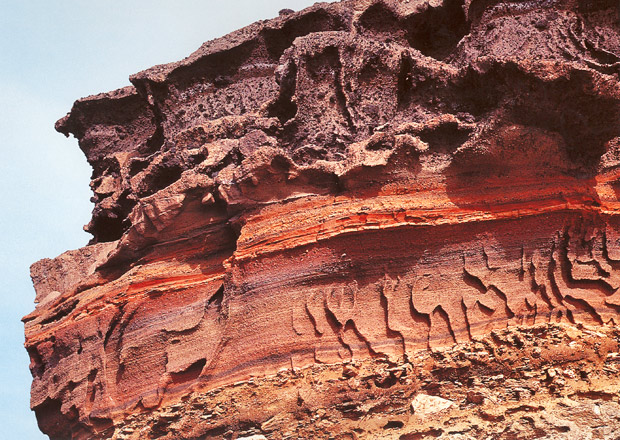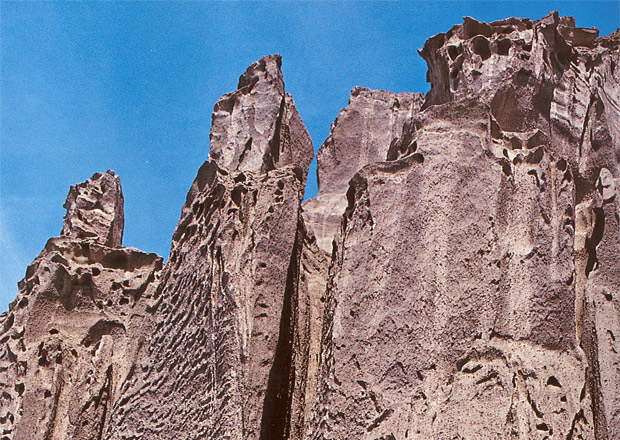Pre-eruption signs
Excavations in Akrotiri have brought to light some evidence that there were warning signs before the Minoan eruption. There must have an earthquake that scared the citizens who were made to quit their houses. Ruined houses and broken steps have been found yet no human bones or precious items were discovered. However, the murals confess that the ancient residents used several tools and jewellery. Probably they had manage to resort to a safe place where they transferred their belongings as well. Moreover, two volcanologists from America noticed a light layer of ash, almost 8 cm thick, around Akrotiri, which they consider as a material that is produced before the eruption, by steam and pumice dust.
Plinian phase of the eruption
During the first phase of the Minoan eruption a layer of red pumice was laid down. According to scientific measuring the volume of the pumice was 1.4 cubic kilometers and its height was 36-38 kilometers. The eruption column reached the stratosphere and the ashes along with the swinging particles were spread to the north hemisphere and they were to Greenland by the wind.

Pumice layers at Athinios port
During this phase, big pumice masses were exploded high above yet a large part of them fell on the volcano and on the area around it. The sea streams transferred them far away and the wind transferred the tiny dust particles to the east until Anatolia, where they have been found nowadays in sediments. Some scientists have concluded that the plinian phase lasted no more than few hours.
Second phase
The materials that were laid out during the second phase of the Minoan eruption seem to be totally different than those laid out during the other phases because the eruption mechanism had changed entirely. The volcanic pipe became larger and this resulted to the creation of fents through where the sea water bursted. When the water came in touch with the calcined magma the result was amazingly violent as the magma broke into tiny pieces that created clouds of ash and steams were swinging in the air and could be erupted very high thanks to their specific morphology.

Volcanic pumice at Vluchda
According to scientific estimations, 2 cubic kilometers of pumice were exploded above Santorini island. They have created large waved shaping on the surface of the island and scientist had been unable to interpret their existence until they examined the eruption of another volcano situated in Philippines.
Huge lava shards were flinged during both these phases from both sides of the central feed pipe, like bombing rock masses which have traced the ash layers. Some shards with a more than one meter long diameter were erupted even to Akrotiri and they had such a momentum that they manage to break down the stone walls of the settlement of Akrotiri, 10 kilometers away!
Third phase
The products of the third phase can be seen on the caldera wall. They are sphere shaped rock masses of dark lava which, in their majority, are lava from the pre-volcanic island which were erupted with the pumice and the sea water due to the continuous enlargement of the central feed pipe. After the enlargement of the eruption centre, the walls of the crater gave ground and the rocks that precipitated were ball shaped as they had spinned round and round the exploding masses.
The clouds of that phase must have bursted from the sides so they did not reach as high as in the first phase. They were ash streams which consisted of a mixture of gas and solid material that boiled and overflew directing downwards the external sides of the volcano.
The magmatic chamber emptied quickly and the low parts of the volcano collapsed. This led to the creation of the present north basin of the caldera while the existing basins became deeper even though they were filled with pyroclastic material during posterior eruptions.
